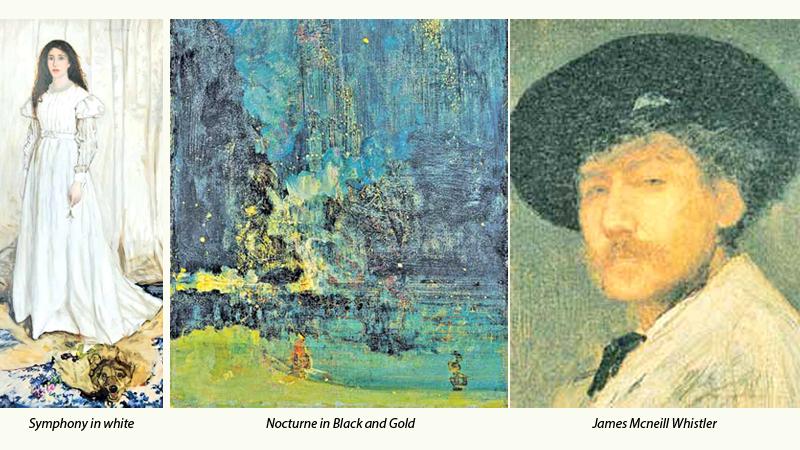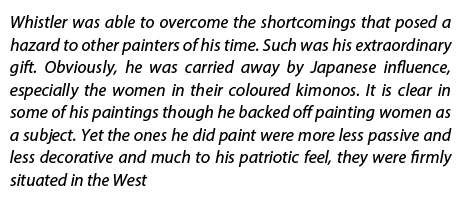
Each painter appear differently to the viewer who has the right to sit in judgement as to what he feels. Ask ten people for their opinion and they all will vary. Take a look at Whistler’s art; it is all freedom and verve, something that many lack because most of them are so tensed up until the paintings are done which subconsciously reveal in some paintings, for example the colour mix-up.
 As with so many of Whistler’s paintings, beauty is not only in formal inventions and painterly innovations but in the freedom of expression both in brush and mind. The gorgeous brushstrokes freely used by the artist in Nocturne in Black and Gold is like fireworks set against a darkened night.
As with so many of Whistler’s paintings, beauty is not only in formal inventions and painterly innovations but in the freedom of expression both in brush and mind. The gorgeous brushstrokes freely used by the artist in Nocturne in Black and Gold is like fireworks set against a darkened night.
He has highlighted only the glow as found in embers, truly a masterpiece in oil and wood, 2312 x 1818 in. 60.3 x 46.6 cm held in the Detroit Institute of Arts. Like falling showers of fire-flakes, art-lovers will realise the magnitude of this art-piece of Whistler. This is just one of his great paintings.
Greek terracotta
He became obsessed with the idea of painting that would combine the grace and simplicity of Greek terracotta statues such as Tarangra figures with stylish designs from orient prints along with artifacts.
They served well his mental capacity. The lightness and delicacy of this technique could not have been more distant to influence the colour artist used in early paintings but not Whistler who had his own colourisaton.
He was able to overcome the shortcomings that posed a hazard to other painters of his time. Such was his extraordinary gift. Obviously, he was carried away by Japanese influence, especially the women in their coloured kimonos.
It is clear in some of his paintings though he backed off painting women as a subject. Yet the ones he did paint were more less passive and less decorative and much to his patriotic feel, they were firmly situated in the West.
Yet, they never destroyed the stylistic mannerisms and visual puns. They were more or less evocative and reminiscent of Degas’ theater paintings.
Whistler was philosophical too and believed that the only thing that is beautiful is the thing that serves no purpose at all. Beauty, he believed, should stand proud and aloof from the world and its deadliest enemies being evil of utility and progress.
Art should exist in its own right, independent of prosaic reality. Was he right? I do not think so judging by his paintings of beautiful women or for that matter, his model who was his mistress.
He is an artist who is most often remembered for his skill in balancing nuances of greys and blues, silvers and opals and especially white…. Pure clear white. Together they excite the art lovers into ecstasy and wonderment.
He had arranged such formal depth and colour mix that one cannot imagine such beauty in paintings and the wizard he was, Whistler marked his own superiority that in the following years that every single art critic knew his identity.
French Impressionists
In some of his paintings I have seen the effect of afterglow in the sky in his habitual practice of painting a dark background before centrally placing his chosen subject.
Very professional and unique but they all came to him naturally the moment he picked his brush. May be that he appeals to me most because I am essentially a white person.
But Whistler can be gloomy and uninteresting to those who wish bright and sparkling colour and all the greens and burgeon outdoor they cannot expect from him.
As an example, French Impressionists’ paintings with their bright prismatic colour and broken brush-work, is seen very distant to them.
I like him best in Symphony in White in which the model is his own beautiful mistress (Jo).
Her delicate beauty is set against a window that captures the mellowed light against a white curtain. To relieve the monotony of a single colour, he has placed a strong light to play upon her face to reveal the long tresses of burnished red that brilliantly throw a glow around her face.
One must study the painting closely and deeply to absorb the uniqueness of its mastery. All his paintings have a clear and iconic feel. He has not slipped anywhere in colour, subject or brushwork which sets him apart from the rest.
Symphony in White or better known as the White Girl hangs in the National Gallery of Art and later at Tate Gallery in London, painted in 1864, oil on canvas, 30 x 20in / 76 x51cm.
James Moneill Whistler was one of the major eccentrics of his time and known as the Prince of his time. He was always regarded as an outsider because of his unorthodox approach to life.
Czar Nicholas
He was the only painter to attend the West Point Military Academy. He spent part of his childhood in Lowell, Massachusetts and later in Russia where his father was employed as a civil engineer and employed by the Czar Nicholas I and when he died unexpectedly, it brought to an end the family’s affluent ex-patriot life.
From there he struggled along with his mother to where he became a super artist. Starting from Paris, he went through his painting process to around the world to meet great painters and be tutored under some.
He was born in 1834 and died in London in 1903. Two memorial exhibitions in Boston in 1904 and a Larger Memorial exhibition in London and Paris were tributes to this great aorist.
